a desk review of new 2-person 3-season tents
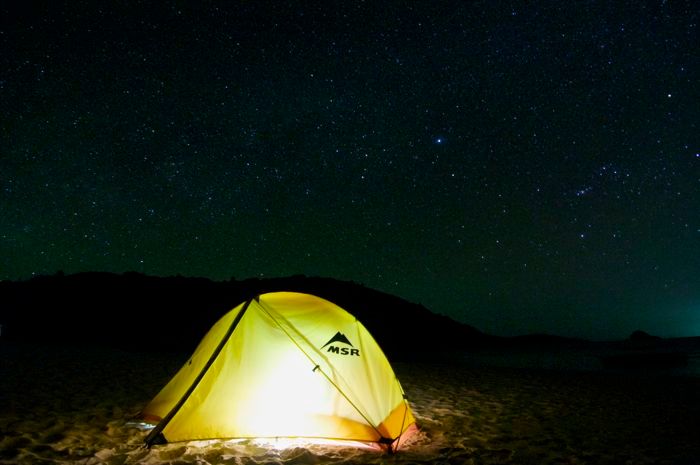
my MSR hubba under the stars on calaguas island
my reputation as an outdoor gear fanatic is such that i often get consulted by friends who are currently planning on making considerable investments to upgrade trail essentials, not just for items i have myself tested, but also for many other things i've lusted after. just over the weekend i offered sage counsel to a friend planning on nylon accommodations for one person, although her primary consideration, as is many others', was price. she didn't even bother to look at beautiful models priced higher than USD 150. of course that severely limited her options, but it didn't mean that i couldn't help shape her decisions on what to buy. given these parameters, i can still make suggestions, although i always end by pushing the envelope, such as: if you add a few more dollars, you could get this instead.
her question was rather timely as i've actually been looking at new tents since january, when they have online-only offers of new models that actually don't become available until after some time. the search became more intense just after i went through a night without sleep, watching my tent crumble and pop back up while i was inside it. when i do my research, i like to compare features, such as the size of both the tent interior and the vestibules, the weight, the price, and the pole configuration. i've already filtered my search to 2-door, 2-person 3-season tents, so you could say that design is my primary consideration. my bias for this particular type of tent is based on experience: i hate it when someone crawls over me in the middle of the night just to answer an urgent call of nature, or when we have to jostle for space in the vestibule to store shoes and other items that can't be stuffed inside - a consequence of having a single door.

the green tent at the center of the mount pulag saddle campsite is my MSR hoop 2
i look at all the available models, and jot down their technical specifications, and make my decision ultimately based on weight, price, and pole configuration. it used to be that price would get the highest points in my criteria, but as you get older and less able to stuff your backpack with unnecessary ounces, you realize that your desire for comfort outweighs the need to save a few dollars. so although my first tent was a TNF talus 23, which is tested to withstand gale-force winds but tips the scale at a whopping 6.6 pounds (3 kilograms!), my current tent of choice is the REI quarter dome 1, which is just a shave over 2 pounds (less than a kilo even). now i wonder how i managed to carry all that weight around.
so although it was the REI quarter dome 1 that bore the brunt of balingkilat's tantrum, i'm currently not looking to replace it. instead, i want to get rid of its older cousin: my REI quarter dome T2 plus, which has a strange pole geometry that makes it susceptible to strong winds. besides, the waterproof coating of the rainfly has expired. so that is why pole configuration is also an important factor because i've realized that tents that hew too close to the single pole design tend to be weakest, while those that have many crisscrossing poles, such as that seen on modified domes or geodesic models are better at shedding typhoon-class winds.

wiping condensation off my REI quarter dome 1
but what made my comparison of some new and yet-to-be-released tent models difficult was the fact that reviews based on ownership and actual use are not available, so i am making my assessments based solely on the published technical specifications and available pictures. just a note: i've decided to indicate the packaged weight, because in my experience (having bought more than 20 tents, these aren't shipped in boxes, and only have some tags, folded instruction sheets, and not much else. the minimum trail weight is not an accurate indication of how much you'll be carrying, because there is no consistent standard between different tent makers, and it often means leaving behind a few things such as some of the stakes, the guylines, the stuffsack, and sometimes, even the entire tent body. but given the conditions here, it's unlikely that pinoy hikers will choose to have a barebones set-up, or leave things to chance by electing to shave off a few ounces. nevertheless, the packaged weight, unless indicated, does not include the few ounces that could be added by the footprint.
big agnes rattlesnake SL 2
4 lbs 2 oz
USD 349.95

big agnes has an inventory of pretty, pricey tents that are coveted by the outdoor market, and their thoughtful design approach has earned them both praise and what i can only assume is a considerable share in sales. but BA also carries a few mid-priced tents, although older models might still be available in the lower price ranges. this tent is expensive, but may still be considered as one of BA's more affordable models. there's nothing significant about its design, and the pole configuration is usual, although there is the added feature of mtnGLO: the seams in the inside of the tent have a flexible plastic wire that can light up the tent with a soft glow, which is a strange addition if you ask me, and would probably even be removed by gram counters should they dare to purchase a tent that's not under a pound per person. the mtnGLO is also available for a 2015 update to the BA copper spur UL 2, which i didn't bother to include in this review because it's over USD 400.
big agnes ripple creek UL 2
3 lbs 10 oz
USD 399.95
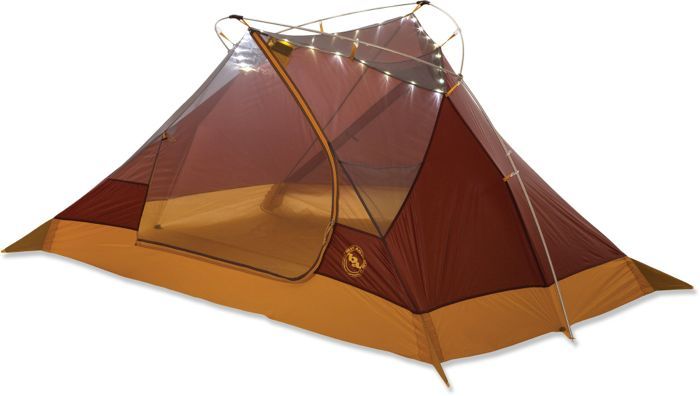
the reason i wanted to do this desk review was primarily that i saw some very weird tent designs for 2015. this is one of them: the tent is actually not free standing, and the pole configuration is basically based on the single pole design, except that there's a halo at the top, whose main aim is to provide the tent with bigger shoulder room by making the walls where the doors are more vertical. the halo provides more space rather than strength, because only the two ends of the pole make contract with the tent floor. tent space shouldn't just be based on the dimensions of the tent floor, which in this case is actually beyond the standard, at 86 x 74 inches (it's less rectangular than most), since tent walls could squeeze you in as they rise to the maximum canopy height. that is why some tents have brow poles and pre-bent poles to pull the tent walls away and form a larger interior space. BA also came out with other new tents, such as the very boring blacktail 2, that's basically a dome tent with a brow pole, and the tumble 2 mtnGLO, which is a christmassy version of the blacktail 2.
marmot amp 2P
3 lbs 5 oz
USD 379
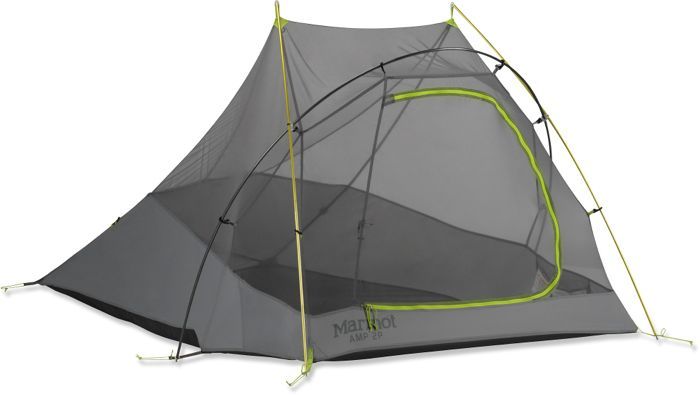
although the inspiration of marmot's newest tent is clear to me, it still comes off as very strange-looking, and it is the reason why it appears in this review despite my bias for 2-door tents. TNF's tadpole tent is so popular that instead of being a specific tent model, filipino mountaineers (a term i use loosely) use that noun as an adjective to refer to specific tent designs that's basically a modified dome, where the poles intersect away from the door, and the headroom is increased by the addition of a third pole to prop up the door (can i just add that TNF probably knew about this fame so it basically re-designed the tadpole last year, and looks nowhere like the old model). marmot must have decided to completely redesign this successful concept by removing the pole intersection close to the tent's footbed. in fact, there are no poles in that area, as they are all concentrated on the area where you find the headroom and the door, allowing the rest of the tent to just slope away until it meets the pegs. i'm not so sure about this drooping fall-away design, and although several tent poles make contact with the tent floor, i doubt whether this is an effective design for exposed campsites. there's also a clear risk that the mesh would feel the way a mosquito net does over your toes, and the absence of anything to pull the vestibule away from the tent body (see nemo's innovation below) would mean that there might be contact between the separate tent fabrics, which is an enemy of condensation, and a burden when it rains. the ounces saved by cutting the tent poles are also not significant since this is not the lightest tent in this review.
marmot force 2P
3 lbs 5 oz
USD 389
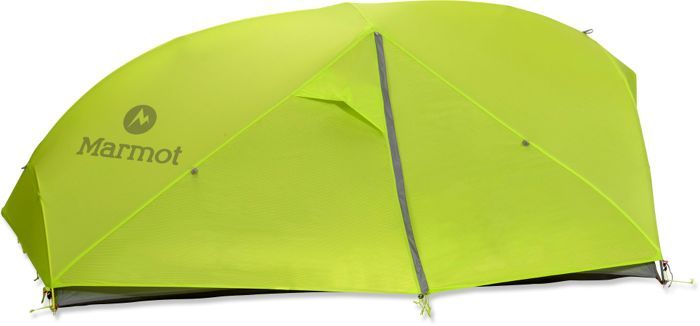
marmot has combined the single pole design with the classic hoop idea before in its bise 2P, as has MSR in its hoop 2, but marmot's new tent takes the concept even further in its force 2P. the variation in this one is that the single pole intersects with the hoops but does not reach the floor, and the 2 or 3 pole sections taken off has paid off since this is just as light as the amp 2P despite having a more complex pole geometry. much was saved when the vestibules were reduced in size though, with one being 6.8 square feet, the other just 3.5 square feet. if i owned this tent, the likelihood is that i'll carry it and will consequently get the bigger vestibule. but i already find the REI quarter dome 1's 6.7 square feet to be barely sufficient to fit my backpack, shoes, and wet clothes and still allow me to step in and out without having to trample on any of them, so i pity the guy who's getting the smaller vestibule. that should be just enough for shoes. i do like this tent though (i have nothing but good reviews for marmot's top-of-class after-sales service) and i can imagine that it must have better resistance to pounding winds with its reinforcement hoops, although my tentmate might resent me and my bigger space. marmot's fuse 2P is cheaper (not by much) though heavier (more than 1 pound, so that's a lot) and has a similar design to the force 2P.
nemo blaze 2P ultralight
2 lbs 5 oz
USD 449.95
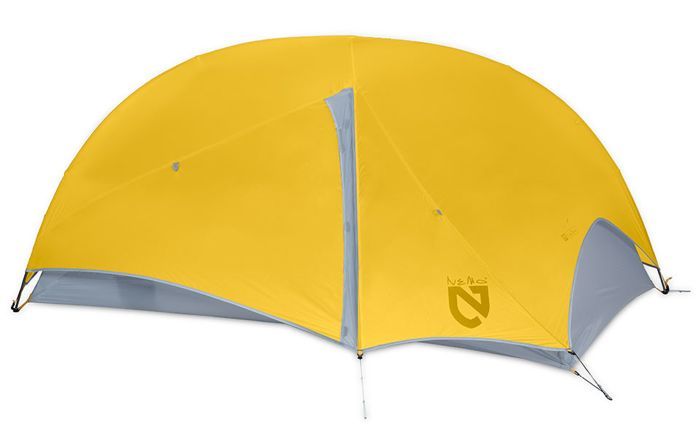
with two doors as well as 2 full-sized vestibules to shame the marmot force 2P, one might wonder what nemo removed to achieve this weight for the blaze 2P ultralight. the answer is this: it's a non-freestanding, single pole tent with a brow pole and tissue paper for its fly. denier is a measurement of thickness of fabrics such as nylon, and my REI quarter dome 1 has an almost see-through 15D which i'm surprised didn't tear during my last outing. the blaze 2P UL, despite its beautiful profile, has a fly and canopy that have less than half that thickness. combined with its single pole, its probably not suited for campsites on barren peaks, or when wind conditions are bound to be tough, because this tent would be ripped to shreds (of course, not literally). i really wouldn't have included it here because of its price tag, but i think it's very interesting, particularly for those willing to sacrifice dollars to save weight.
nemo hornet 2P
2 lbs 5 oz
USD 369.95

if the blaze 2P UL's single pole put you off, perhaps the hornet 2P, also from nemo, might be worth a look, since it's a lot cheaper, has the same amazing weight, and still manages to have 3 hubbed poles make contact with the floor. what nemo removed from this is the brow pole, so the walls tend to bend towards the center ridge pole. to remedy this, the hub is placed between the doors, providing more vertical entryways, and there are on the footbeds what nemo calls "triangulated volumizing guyouts [that] increase interior space", but don't expect to welcome any guests in for a game of cards when the weather is foul. the hornet also has 2 vestibules each with 8 square feet of space and the same 7d rainfly as the blaze 2P, which really is sturdier than tissue paper. also, the hubbed poles might be stronger than having just a single one spanning it entirely, although i have to confess that i wasn't familiar with this company until a few years ago. i've actually only seen 1 nemo tent in action, so i can't say much else except i am very tempted to try this one out. i hope the after-sales service is excellent. by the way, the blaze 2P and hornet 2P are lighter than the also strange flashlight 2FL by sierra designs (which sadly has no new updates or designs for 2015).
nemo dagger 2P
3 lbs 2 oz
USD 399.95

i'm tempted not to look at other tent models after the outstanding specs of the hornet 2P, but if you feel, as i did, that a 7d rainfly might melt under the sun, or dissolve during rain, then you might want to check out other tents that have just been made available. nemo's more traditional dagger 2P has a tent configuration that's so common, it makes me wonder why none of these companies are suing each other. but then again, we are in the 21st century, where supposedly there are no longer any new ideas, and where, to paraphrase T.S. eliot, immature designers imitate, mature ones steal. but i digress. the dagger 2P has a slightly bigger interior and a higher canopy, but a marginally smaller vestibule than the blaze 2P. i think nemo came up with this one as a model for those who think their ULs are too feeble and their tanks are too heavy (the losi 2P with its web of aluminum poles is 5 lbs 1 oz).
REI dash 2
2 lbs 15 oz
USD 349

REI's dash 2 is actually already a year old. i had misgivings about it when it first became available for pre-orders, but it merits a place in this review because it takes many cues from nemo and the BA angel springs by cutting out parts of the rainfly, which shaved a few ounces off its weight and contributed to its strange shape, and exposed the foot area of the tent canopy and the lower part of the headroom. the pole configuration is also a bit odd: the brow pole is located at the foot end of the tent, and in order to make walls more vertical and increase the space, REI has an "exclusive tension-truss architecture" (whatever that means), and side poles that are bent on their way to the grommet by another hub that allows for an angle that's not quite 90 degrees. the dash is REI's lightest 2-person tent (so far), and it was released along with the quarter dome 1. i'm waiting to see if REI will be coming out with new models this year, or re-issue the dash (they could take a hint from nemo's "volumizing guy outs", take off the crosspole, and reduce the weight by 3 ounces). the dash 2 is actually among the first to call out minimalist tents which take away too many of the usual comforts i'm used to. the dash claims to still have all these (2 doors, 2 vestibules, double walls) and still be in this weight range.
unfortunately, other tent makers have all but used up their ideas and have not bothered to issue new models for 2015. MSR, a company i like and admire, has just decided to update and upgrade all their current tent models, replacing fabrics and poles. TNF re-issued all their famous tent models, with the current tadpole and talus not looking like their older incarnations. it could have updated its very popular and award-winning mica 2 tent, but it's still not clear whether anything new will be released soon. kelty won accolades as well for its trailogic TN2, although the welded window is a dealbreaker for me. if they decide to update it with a window-less lighter fly, i would consider it because it has one of the best pole configurations for its weight. i wonder if i could email these companies randomly and make suggestions about possible tent designs and upgrades. i'm sure i can, but will they take heed?